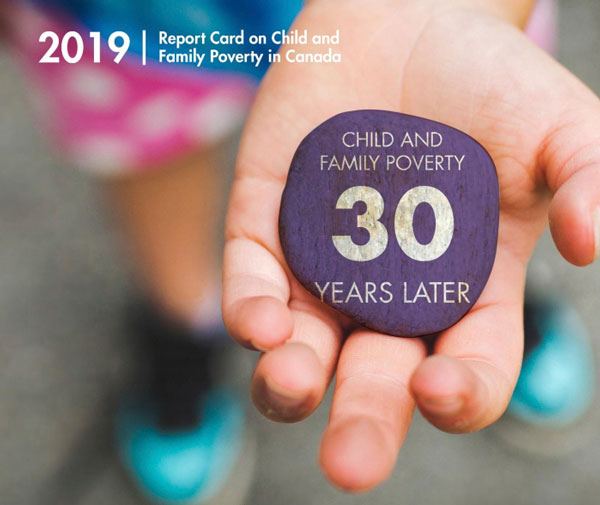
A report released on Tuesday shows a lack of progress in reducing child poverty 30 years after the House of Commons voted to end the issue by the year 2000.
2020: Setting the Stage for a Poverty-Free Canada was released by Campaign 2000, a public education movement dedicated to ensuring government officials properly address child and family poverty since their promise in 1989.
Kickstarting a new decade under a minority government, Campaign 2000 has released a set of recommendations so the country doesn’t “fail another generation of children.”
“As a community, Canadians hold a collective responsibility not only to protect children from harm but to protect their rights and quality of life as citizens and residents of Canada. They are among the most vulnerable in our population.”
According to the yearly report card, the national child poverty rate has slowly decreased by 3.3 percentage points between 1989 and 2017, an average of .12 percentage points per year. At that rate, it would take 155.8 years to eliminate child and family poverty.
The most recent data shows 1,356,980 children are living in families with after-tax income below the Census Family Low Income Measure After Tax. Of those youth, 18.6 per cent of children are under 18 and 19.6 per cent, or 462,360 children, under the age of six.
Campaign 2000 highlighted potential improvements regarding topics such as housing, childcare, pharmacare, food security and measuring poverty.
Under the section titled “Eradicating Child and Family Poverty Among Indigenous Peoples,” Campaign 2000 noted the demographic is in need of “urgent change.” One in four Indigenous people in Canada are living in poverty.
Out of all Indigenous communities, status First Nations children experience the highest level of poverty—53 per cent are living in poverty on First Nations reserves and 41 per cent are living in poverty in other communities. Métis children experience poverty rates of 22 per cent and Inuit children of 25 per cent.
The Desnethé—Missinippi—Churchill River riding in Saskatchewan has one of the highest rates of poverty at 59.4 per cent, although the report noted it’s also home to large First Nations communities.
Campaign 2000 emphasized the importance of measuring poverty rates among the Indigenous population. Canada’s official poverty measure, the Market Basket Measure (MBM), does not yet apply to First Nations reserves nor territories.
It noted other limits to the current poverty measure.
The MBM establishes a of low income threshold by dividing out costs needed for a standard of living. These include costs for food, shelter, clothing and transportation.
“Certain important non-discretionary items have been left out of the basket including childcare, prescription medication and mandatory payroll deductions (and instead are deducted from total income when calculating disposable income), and shelter costs are underestimated. This all contributes to reduced poverty thresholds,” reads the report.
The MBM is currently under review and is expected to be updated next month.
In the last section of the report card, “Poverty Erodes Public Health,” it says people in poverty don’t have much money leftover for basic healthcare needs. After paying their housing costs, which are rising faster than wages, families don’t often have the money for prescriptions or healthy food.
In addition, the report says people living in poverty are disproportionately affected by chronic disease, depression and higher mortality and morbidity rates. The report links these issues to food insecurity, especially early in life.
Another major issue, as it states, is a lack of childcare.
“ECEC (Early Childhood Education and Care) should be a universal entitlement, not a targeted program serving only low income children or a commodity for families who can pay high fees,” states the report.
“For too many Canadian families, finding childcare is still like winning the lottery—a matter of luck. Canada remains an outlier—one of a few wealthy countries with no real plan for building a universal ECEC system.”
A chart included in the report shows median monthly pre-school fees in major Canadian cities. Saskatoon is averaged at $730 per month and Regina at $597 per month.
It states that Canada has regulated childcare spaces for fewer than three in 10, or 28.9 per cent, for children zero to five years old. Additionally, childcare is often less than optimal and hinders efforts to close the gender employment gap.
This is only a few of several topics Campaign 2000 touches on in 2020: Setting the Stage for a Poverty-Free Canada. Other topics include assessing the country’s Poverty Reduction Strategy, lifting marginalized children out of poverty (which notes that people who are vulnerable to poverty face barriers accessing the Canada Child Benefit), boosting family incomes, the nature of the changing workplace and tax fairness.
Campaign 2000’s overarching set of recommendations include:
- Increase the Canada Child Benefit – ensure vulnerable populations have access
- Allocate $6 billion in the 2020 budget to reducing poverty by 50 per cent by 2025 based on the Census Family Low Income Measure After Tax
- Collaborate with First Nations, Inuit and Métis governments and organizations
- Transfer $1 billion to provinces, territories and Indigenous communities for building accessible, affordable and high quality childcare and early learning in 2020-21
- Enhance the National Housing Co-Investment Fund with $3 billion annually
- Commit to implementing a universal public pharmacare plan
- Ensure that the food policy for Canada uses income-based interventions to address needs of low income families
The non-partisan coalition of 120 partners also gives specific recommendations after each section. To read the full report, visit www.campaign2000.ca.

